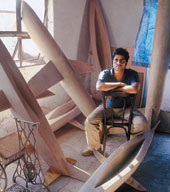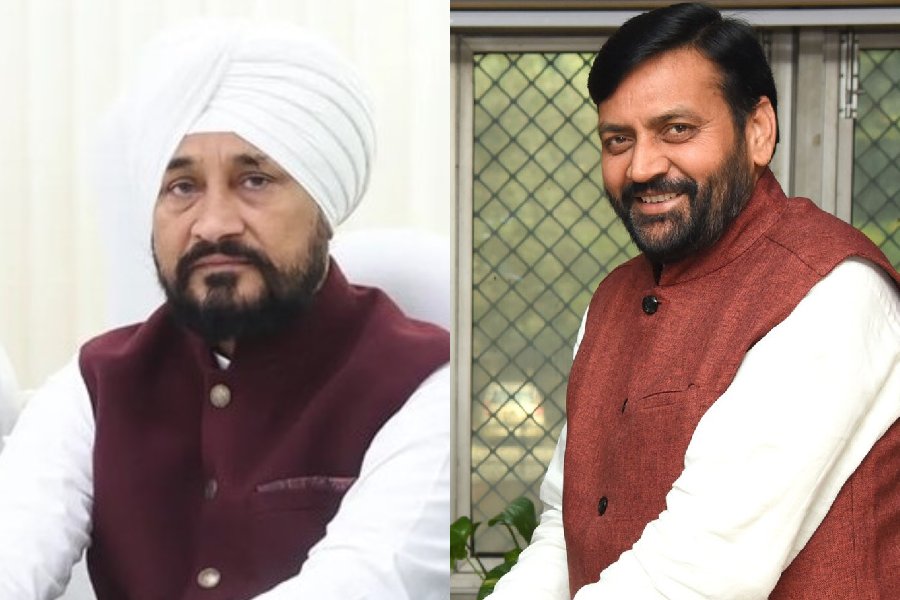 |
 |
| Sudarshan Shetty in his studio with an unfinished work; (above) an exhibit from Consanguinity |
It was a striking display in more ways than one. Called ?Party is Elsewhere?, it consisted of two tables, 365 wineglasses and a hammer that periodically struck one of the tables without smashing the wineglasses. Says artist Sudarshan Shetty, who assembled the unusual creation, ?I bring disparate objects together and create a new meaning.?
For the average man in the street, Sudarshan?s meaning might be tough to comprehend. But Sudarshan is an installation artist. He and others like him are stepping out of the confines of oil and canvas in their efforts to deliver a new, complex message to the world at large.
Perhaps a swift primer is necessary. First, it?s important to understand that outside India, installation art is not new, or at least not very new. Installation art has been around ever since Marcel Duchamp put a urinal in a New York gallery in 1917 and scandalised the art world.
Since then, others have followed in Duchamp?s pioneering footsteps. In Britain in the ?90s, Damien Hirst famously sliced a cow and calf in half and suspended them in a glass case filled with formaldehyde. The work, along with ones of a shark and a sheep preserved behind glass, met with loud cries of derision from many reviewers who suspected they were being dragged into a bizarre publicity stunt.
Now, a group of Indian artists are also trying their hand at installation art ? although not taking it to such lengths as Hirst. Take a look at what Bose Krishnamachari has been turning out. Krishnamachari wears the mantle of an avant garde artist with consummate flair and has been charting his own individual course since the 1990s. One of his well-known installations which got rave reviews was a creation intriguingly titled AmUseuM. The work consisted of a series of open, spiral bound books, their pages glued together and painted over, with poems written on them, framed in glass like museum exhibits. ?I think I am a watchman of the contemporary art scene,? says Krishnamachari.
 |
| Bose Krishnamachari with a work in progress |
Some might call that a pretty sweeping statement. Anyway, suffice to say that installation art is not for traditionalists who like their oils on canvas. In this art form, the medium really is the biggest part of the message. While the artist may have his own message, it may not be evident unless you?ve bought the exhibition catalogue and in any event, you?re quite free to walk away with your own interpretation!
What?s certain, is that installation art isn?t on canvas and it isn?t sculpture. It makes use of everything from hammers and wineglasses to lasers and video technology.
The main aim ? according to the artists themselves ? is to try and challenge accepted ideas by making us see familiar objects in different ways. Take artist Baiju Parthan who?s obsessed with modern machines and their impact on human beings. Two years ago, Parthan?s futuristic creation, Diary of the Inner Cyborg, was hailed when it went on show at the Japan Foundation Gallery, Tokyo. In good traditional style, Parthan does put brush to canvas. But he has also done digital installations and even hybrid multi-media installations.
Parthan is an artist who wants to be part of the cyberage. He has studied computers, learned hardware engineering, and even built his own machines and created computer programs. ?I didn?t want to be afraid of technology,? he says. ?Today, the machine has become the ?Other? for humans, and it raises philosophical issues that we have to grapple with.?
Parthan?s work is inspired by the influence of technology on religious beliefs, the implications of genetic engineering, and the possibilities of post-humanism ? for example the development of symbiotic relations between man and machines.
 |
 |
| Chitrabhanu Majumdar (above) and his untitled work |
?The obvious reason for my resorting to installation art as a parallel practice is the complexity of this subject. It is rather difficult to accommodate such a complex and multi-layered idea within the framework of canvas and paint,? says Parthan who began to study computers in 1995. Ever since then, he has mainly focused on installation art.
Galleries too are embracing the cyberage and the new arts forms that are now coming into being. During the 2004 national elections, the Calcutta art scene got a taste of installation art with ?Vote Tumi Kar?? (Vote To Whom Dost Thou Belong?). The exhibition by a clutch of artists was a spoof on the electoral process. It used a mix of theatre, video, animation, painting, installations, music, caricature and graffiti to drive home its point. Says Pratithi Sarkar, chief administrator, CIMA Gallery which organised the show, ?Art has redirected and expanded its borders to comprise new areas of content and experience.?
Of course there will always be those who say installation art, because it often lacks apparent craftsmanship, seems like an art form dressed up in the emperor?s new clothes. But one good thing its champions say is that ? love it or hate it ? at least it gets art gallery goers talking and involved, maybe because it is so controversial.
In Calcutta too, a lot of talented artists are experimenting with this medium. There are people like Chitrabhanu Majumdar, Adip Dutta, Paula Sengupta and Eleena Banik who?ve all moved in their own unique directions to send out their messages to the world. Sengupta, for instance, has a background in printmaking and integrates it in her work. She argues that galleries aren?t always the ideal spaces for her type of art. Majumdar, reckoned to be one of the most talented of this generation of artists did a highly acclaimed installation at the Sacred Spaces exhibition at the Jehangir Art Gallery.
Banik moves from one medium to another. For a start, she has done paintings, collages and sculptures. In addition, she has also turned out video and multi-media installations. For instance, two years ago, her installations, which featured in the Roots-En-Route exhibition, consisted of lullabies and fairytales placed in paper carrybags collected during her travels around the globe. Says Banik, ?This work is a protest against plastic bags and is about the use of environment-friendly alternative material. I feel it is my duty to deliver my message of peace and creativity. And through my work, I?m trying in my own humble way to soothe the world.?
 |
 |
| Baiju Parthan (above) and his work, Diary of the Inner Cyborg |
A bigger question is whether installation art is feasible in India? Says Delhi-based artist Vivan Sundaram, ?Installation art is not very successful in this country because people tend to be more conservative towards art.?
Then, there?s the question of space. This isn?t the kind of work you can hang up in your drawing room. It requires huge spaces and is usually put up in museums and corporate houses.
Nevertheless, scores of galleries haven?t let this stop them. In Calcutta, galleries like the Birla Academy, CIMA, Gallerie 88 and Gandhar have held installation art exhibitions. So have others like Mumbai?s Jehangir Art Gallery and the National Gallery of Modern Art.
Says Geetha Mehra, director, Sakshi Gallery, Mumbai, ?We have consistently exhibited installations as we feel that artists should have a forum to show experimental work and make radical statements, if they so choose to. For the artist who cannot say it all within the confines of a canvas, installations become a means of communicating their thoughts and ideas more effectively.?
There are still those, however, who believe that installation art will not thrive in this country. Some argue that this art form can only be understood by a small coterie of art lovers and critics. And others like curator Ina Puri say that nothing original has yet been created here. Says Puri, ?There are few original works in our country. In fact, most of the works are very derivative, works that you would get to see abroad.?
But installation art has its defenders. Says Vibhuraj Kapoor of Gallery Beyond, ?Installation art sends an implicit invitation to the viewer to participate ? to enter, be absorbed, and surrounded. This is a change from the situation where you gazed at an object on the wall as an outsider.?
It goes without saying that these huge installations cost money ? and lots of it. The galleries are not always able to support the display of installation art because they are tough to sell ? indeed sometimes unsaleable. Says Shetty, ?One has to keep in mind that installation works are huge pieces of work and no single person can buy a whole piece.?
Adds Banik, ?It?s a known fact that installations cannot be bought in totality. However, one can buy a part of it and treasure it as a collector?s item.?
Some gallery owners also feel that installations are an attempt to get away from the buying and selling of art. ?The practice seeks to de-commodify art and allow it to remain ?art for art?s sake? where the collector is not buying a signature but is viewing the piece, without installing it in his/her home.
Which way is it all heading? Remember that today?s avant garde creations could well be tomorrow?s mainstream work. Says Mehra, ?What?s new one day becomes acceptable art practice the next day.?
Photographs by Gajanan Dudhalkar
Stepping out of the canvas
• Navjot Altaf ? He studied Fine and Applied Arts at Sir J. J. School of Arts, Mumbai. Some of his exhibitions were: in 2001-2003, Three Halves, Installation with Audio and Video; in 2000-2002, Nalpar, site-oriented sculptural structures (Kondagaon, Bandhapara and Ambalpur; in 2001-2002, Between Memory and History, installation with video, audio and text. In 1994, Links destroyed and re-discovered, an installation with paintings, screen prints, films and music, (Jehangir Art Gallery, Mumbai).
• Nalini Malani ? Majored in fine arts from the Sir J.J. School of Art, Mumbai. She is a multimedia artist with an extensive exhibition history. Her practise encompasses drawing and painting, as well as the extension of those forms into projected animation, video and film. Malani is committed to the role of the artist as social activist and often bases her work on the stories of those who have been ignored, forgotten or marginalised by history.
• Shilpa Gupta ? Gupta works in a variety of media loosely grouped under the heading of Conceptual Art. A web designer by profession, her art merges subtle comments on global exploitation and disparate identities.
• Shakuntala Kulkarni ? A visual artist who has been making installations using multi-media, and adopting an interdisciplinary approach to visual language for the last ten years. She has held several shows in India and abroad.











